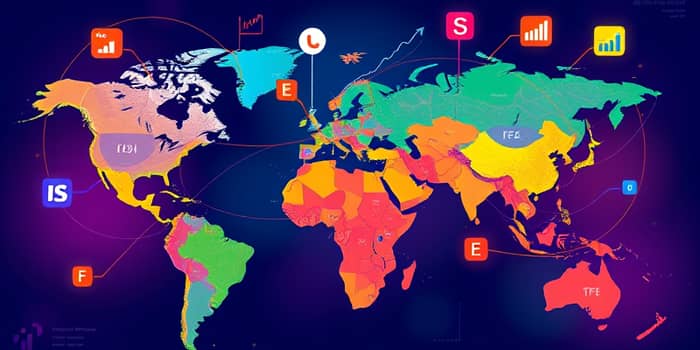In today’s interconnected economy, investors must look beyond domestic markets to build robust portfolios. Spreading investments across countries and regions helps reduce dependence on any single market’s performance. By integrating international exchange-traded funds (ETFs), you can access a broader array of growth opportunities, smooth out portfolio volatility, and introduce valuable currency diversification. This guide explores why global ETFs matter, how to allocate them strategically, and practical steps to incorporate them safely into your long-term investment plan.
Why International Diversification Matters
Concentrating all assets in one economy leaves you vulnerable to political unrest, economic downturns, and market-specific shocks. A diversified global portfolio cushions these impacts by minimizing home-country risk over time. When one region underperforms, another may outperform, helping stabilize total returns.
Moreover, many high-growth sectors—like renewable energy in Europe or technology in Asia—offer potential returns not available in your domestic market. International diversification also introduces currency exposure: if your home currency weakens, holdings in stronger currencies may offset losses and preserve purchasing power.
Global ETFs: A Powerful Diversification Tool
ETFs provide cost-effective access to international markets without the complexity of buying individual foreign stocks. They trade like stocks on U.S. exchanges, offer instant liquidity, and often have lower expense ratios than actively managed funds. There are four primary types of international ETFs:
- Broad international (e.g., total world ex-US funds)
- Regional ETFs (Europe, Asia-Pacific, Latin America)
- Country-specific ETFs (Japan, China, Brazil)
- Sector-focused international ETFs (global technology, healthcare)
- Emerging market ETFs (MSCI EM, FTSE EM indexes)
Choosing the right type depends on your risk tolerance and growth objectives. Broad funds offer simplicity and broad coverage, while country or sector funds allow targeted exposure to specific opportunities.
Strategic Allocation Guidelines
Investment experts recommend dedicating a meaningful slice of your portfolio to international assets. Vanguard suggests allocating 20%–40% of equity holdings to non-U.S. stocks and up to 30% of fixed-income allocations to global bonds for full diversification benefits. However, correlations among major markets have increased, so the incremental risk reduction for U.S. investors can be modest. Emerging markets often exhibit lower correlations and higher volatility, which may bolster returns but raise portfolio risk.
Managing Risks and Avoiding Pitfalls
While international ETFs unlock new opportunities, they introduce unique risks. Tracking error, higher expense ratios, and currency fluctuations can all impact performance. Monitoring overlap in sector exposures is critical: some global funds hold large amounts of U.S. mega-cap names, inadvertently boosting domestic concentration.
- Currency risk: Gains in foreign markets may be offset by currency depreciation.
- Higher tracking errors: Especially in less-liquid emerging markets.
- Regulatory and geopolitical risks: Sudden policy changes can affect local markets.
Stay informed about macroeconomic developments, maintain diversified currency exposure, and choose ETFs with solid liquidity and transparent holdings to mitigate these risks.
Practical Steps to Build Your Global ETF Portfolio
Creating a well-balanced international allocation involves careful planning and ongoing management. Follow these steps to integrate global ETFs safely:
- Select the right mix: Decide between broad, regional, country, or sector funds based on your objectives.
- Compare costs and liquidity: Lower expense ratios and tighter bid-ask spreads enhance long-term returns.
- Check for overlap: Review fund holdings to avoid unintended concentration in industries or large-cap names.
- Use fractional shares: Many brokers allow buying partial ETF shares to fine-tune allocations with smaller capital.
- Set target allocations and rebalance: Review your portfolio at least annually to maintain your desired international exposure.
Historical Performance and Research Insights
Data from 2003 to 2019 shows that emerging market ETFs delivered the highest total returns but also the greatest volatility. In contrast, U.S.-focused ETFs achieved superior risk-adjusted returns as measured by the Sharpe ratio. Vanguard’s research confirms that a balanced blend of developed and emerging market exposure can smooth long-term performance and enhance growth potential.
Expense ratios for international ETFs tend to exceed those of domestic funds by 10 to 50 basis points. Tracking errors are also more pronounced in less-established markets. Nonetheless, the diversification benefits—especially during periods of regional underperformance—often compensate for these costs.
Conclusion: Embracing a Global Outlook
International diversification through global ETFs is not merely a hedge against domestic downturns—it’s a strategic pathway to uncover new growth prospects. By following a disciplined approach of strategic global asset allocation, rigorous due diligence, and regular portfolio rebalancing, investors can build resilient portfolios capable of weathering market storms.
Adopting a global mindset broadens your investment horizon, empowers you to capture emerging trends, and helps protect your wealth from unforeseen regional shocks. Take action today to integrate international ETFs and secure a more balanced, opportunity-rich portfolio for the future.
References
- https://www.flexfunds.com/flexfunds/etfs-and-investment-portfolio-diversification-how-can-they-help-reduce-risk/
- https://www.ssga.com/us/en/intermediary/insights/etf-market-outlook/diversify-portfolios-with-alternatives
- https://investor.vanguard.com/investor-resources-education/understanding-investment-types/why-invest-internationally
- https://www.investopedia.com/articles/exchangetradedfunds/11/advantages-disadvantages-etfs.asp
- https://www.privatebanking.hsbc.com/investing/discretionary-portfolio-management/importance-of-global-diversification/
- https://www.investopedia.com/articles/exchangetradedfunds/11/building-an-etf-portfolio.asp
- https://aquila.usm.edu/cgi/viewcontent.cgi?article=1757&context=honors_theses
- https://www.bankrate.com/investing/best-etfs/










